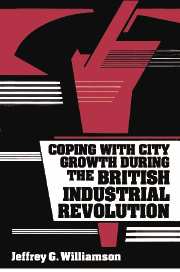Book contents
- Frontmatter
- Contents
- List of tables
- List of figures
- Acknowledgments
- 1 Coping with city growth, past and present
- 2 The urban demographic transition: Births, deaths, and immigration
- 3 Migrant selectivity, brain drain, and human capital transfers
- 4 The demand for labor and immigrant absorption off the farm
- 5 Absorbing the city immigrants
- 6 The impact of the Irish on British labor markets
- 7 Did British labor markets fail during the industrial revolution?
- 8 Did Britain's cities grow too fast?
- 9 City housing, density, disamenities, and death
- 10 Did Britain underinvest in its cities?
- References
- Index
4 - The demand for labor and immigrant absorption off the farm
Published online by Cambridge University Press: 03 May 2010
- Frontmatter
- Contents
- List of tables
- List of figures
- Acknowledgments
- 1 Coping with city growth, past and present
- 2 The urban demographic transition: Births, deaths, and immigration
- 3 Migrant selectivity, brain drain, and human capital transfers
- 4 The demand for labor and immigrant absorption off the farm
- 5 Absorbing the city immigrants
- 6 The impact of the Irish on British labor markets
- 7 Did British labor markets fail during the industrial revolution?
- 8 Did Britain's cities grow too fast?
- 9 City housing, density, disamenities, and death
- 10 Did Britain underinvest in its cities?
- References
- Index
Summary
Internal migration between farm and nonfarm employment
The previous two chapters have focused on migration between city and countryside. What about migration off the farm? After all, the countryside offered nonfarm employment opportunities, and these were quite significant in most parts of England. Under such conditions, rural emigration and off-farm emigration need not have been the same.
Not too long ago, Sidney Pollard (1978) offered estimates of emigration from British agriculture over the century following 1751, concluding that “only about one-fifth of the additional working force in nonagrarian occupations was derived from the direct transfer out of agriculture,” and by comparison natural population increase was of “immense importance” (Pollard, 1978, Table 34 and p. 141). Pollard's conclusion would appear to be at variance with Chapter 2, in which we found that immigration contributed to about half of city growth (Table 2.5). However, Pollard made his calculations based on simplifications that matter to his conclusions. First, he ignored external migrations in his calculations, the Irish in particular. In effect, he treated the Irish as part of the nonagricultural natural increase. Second, Pollard assumed that the rate of natural increase was the same everywhere. I am sure that Pollard would be the first to agree that the natural rates were quite different in agriculture and nonagriculture. As we have seen in Chapter 2, the rate of natural increase was much higher in the countryside. The natural rate differentials were, in fact, much higher than in the contemporary Third World, making the problem of matching excess urban labor demand with excess rural labor supply all the more difficult.
- Type
- Chapter
- Information
- Publisher: Cambridge University PressPrint publication year: 1990



